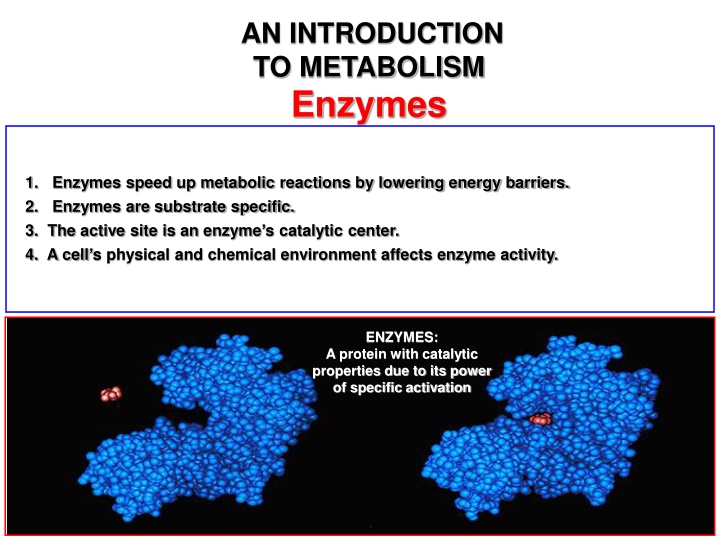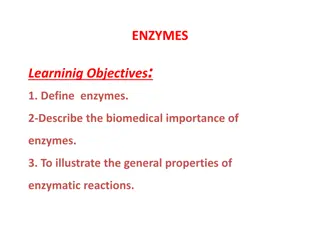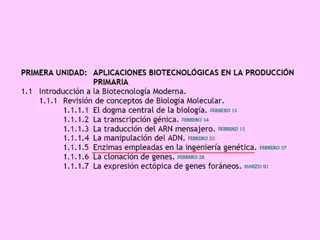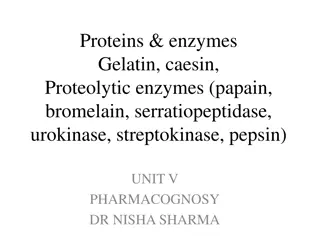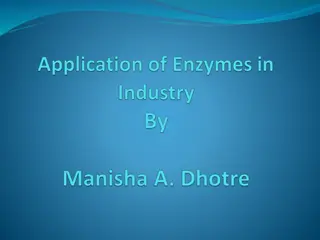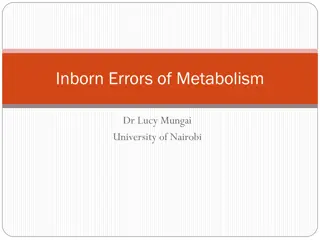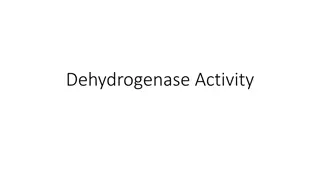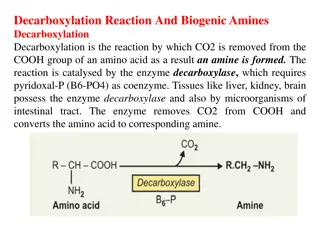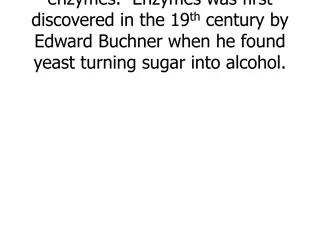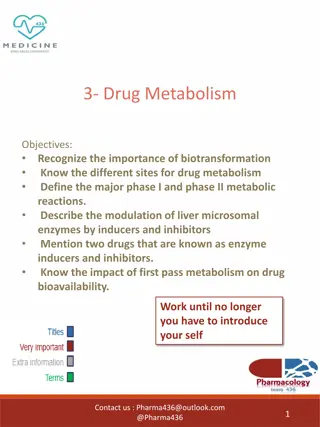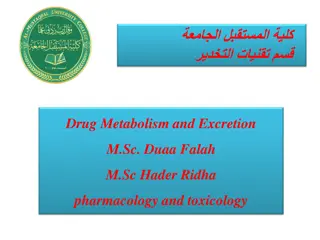Introduction to Enzymes and Metabolism
Enzymes play a crucial role in speeding up metabolic reactions by lowering energy barriers. This process involves substrate specificity and the presence of an active site within the enzyme. The activation energy required for reactions is influenced by enzymes, which act as catalysts to facilitate chemical reactions. Understanding how enzymes function in metabolism is essential for appreciating cellular processes.
Download Presentation

Please find below an Image/Link to download the presentation.
The content on the website is provided AS IS for your information and personal use only. It may not be sold, licensed, or shared on other websites without obtaining consent from the author.If you encounter any issues during the download, it is possible that the publisher has removed the file from their server.
You are allowed to download the files provided on this website for personal or commercial use, subject to the condition that they are used lawfully. All files are the property of their respective owners.
The content on the website is provided AS IS for your information and personal use only. It may not be sold, licensed, or shared on other websites without obtaining consent from the author.
E N D
Presentation Transcript
AN INTRODUCTION TO METABOLISM Enzymes 1. Enzymes speed up metabolic reactions by lowering energy barriers. 2. Enzymes are substrate specific. 3. The active site is an enzyme s catalytic center. 4. A cell s physical and chemical environment affects enzyme activity. ENZYMES: A protein with catalytic properties due to its power of specific activation 1 Pages 96 - 103
Hydrolysis of sucrose (table sugar) Dehydration Glucose + Fructose Sucrose Hydration (H2O) Sucrase Glucose + Fructose Hydrolysis of sucrose in the presence of Sucrase results in its two monosaccharide components. This process include: 1- Breaking the bond between Glucose and Fructose; 2- Then, forming new bonds with H+ and OH- from water This process consumes energy (Activation Energy; EA)
Enzymes speed up metabolic reactions by lowering energy barriers A catalyst is a chemical agent that changes the rate of a reaction without being consumed by the reaction. An enzyme is a catalytic protein. Chemical reactions between molecules involve both bond breaking and bond forming. To hydrolyze (hydration) sucrose, the bond between glucose and fructose must be broken via hydrolysis in the presence of sucrase (the catalyst). Sucrase
Enzymes and Activation Energy Activation Energy: It is the minimum amount of energy needed to start a reaction. It is the amount of energy needed for the reaction (between enzyme & substrate) to complete (to break the bonds). Raising the temperature for these reactions to complete will either denature the compounds or kill the cell. Thus, organisms must therefore use a catalyst. Catalyst: It is a chemical agent that accelerate the reaction without being consumed by the reaction. Enzyme is a catalytic protein Enzyme is a specific catalyst for specific reactants at any time in the cell (e.g. Sucrase for only Sucrose).
Activation energy: is the amount of energy necessary to push the reactants over an energy barrier. At the transition state, the molecules are at an unstable point. The difference between free energy of the products and the free energy of the reactants is the delta G. Enzyme can increase the rate of reactions by lowering EA. The transition state can then be reached even at moderate temperatures. 5
Enzymes are substrate specific The substrate is a reactant which binds to an enzyme. When a substrate binds to an enzyme, the enzyme catalyzes the conversion of the substrate to the product. Sucrase (catalyst) is an enzyme that binds to sucrose (substrate) and breaks the disaccharide into fructose and glucose (products). Enzyme (a catalyst) Substrate Product (s) Sucrase Glucose + Fructose Sucrose + H2O Specificity of enzyme refers to the shape of its Active Site intowhich fits the surface of the substrate.
The active site is an enzymes catalytic center The active site of an enzymes is the groove on the surface of the enzyme into which the substrate fits. The specificity of an enzyme is due to the fit between the active site and that of the substrate. As the substrate binds, the enzyme changes shape to fit the substrate, bringing chemical groups in position to catalyze the reaction.
Active site of enzyme and Catalytic Cycle Sucrase Sucrose Glucose Fructose H2O
Catalytic Cycle of Enzyme 1- The substrate binds to the active site of enzyme. 2- This forms an Enzyme-Substrate complex (via weak hydrogen bonds). 3- The active site catalyses the conversion of the substrate to final products (original components) by breaking bonds. 4- The resulting products release from the enzyme. 5- The enzyme starts another reaction over and over again. 6- Thus, the enzyme can have a huge metabolic effect in the catalytic cycle.
A single enzyme molecule can catalyze thousands or more reactions a second. Enzymes are unaffected by the reaction and are reusable. Most metabolic enzymes can catalyze a reaction in both the forward and reverse direction. The actual direction depends on the relative concentrations of products and reactants. Enzymes catalyze reactions in the direction of equilibrium. Enzymes lower activation energy and speed a reaction. The rate that a specific number of enzymes converts substrates to products depends in part on substrate concentrations. At some substrate concentrations, the active sites on all enzymes are engaged, called enzyme saturation.
A)- Cellular factors affecting enzyme activity Changes in shape of the enzyme molecule influence the reaction rate. Some conditions lead to the most active conformation and lead to optimal rate of reaction. These factors are:- Temperature: has a major impact on reaction rate. 1. As temperature increases, reaction between substrate and active sites occur faster. However, at some point thermal increase begins to denature the enzyme. Each enzyme has an optimal temperature. 12
2. pH also influences the reaction rate, each enzyme has an optimal pH falls between pH 6 - 8 for most enzymes. However, digestive enzymes in the stomach are designed to work best at pH 2 while those in the intestine are optimal at pH 8, both matching their working environments. 3. Cofactors : A non-protein helpers for catalytic activity of enzymes. They bind permanently to the enzyme and include two types:- a)- Inorganic cofactors, include zinc, iron, and copper. b)- Organic cofactors, include vitamins or molecules derived from vitamins.(coenzymes)
B)- Enzyme inhibitors Inhibitors are chemicals that reduce the rate of enzymic reactions. The are usually specific and they work at low concentrations. They block the enzyme but they do not usually destroy it. Many drugs and poisons are inhibitors of enzymes in the nervous system. Competitive inhibition : the inhibitor binds to the same site as the substrate, thus prevent the enzymatic reactions. Non-competitive inhibition: the inhibitor binds somewhere other than the active site, resulting in changing enzyme shape. Finally, deactivate the active site 14
Some benefits of enzyme inhibitors The insecticide DDT is inhibitor for key enzymes of nervous system in insects results in death. Many antibiotics (e.g. Penicillin) inhibits enzymes that help bacteria to make their cell walls.
Section C: The Control of Metabolism 1. Metabolic control often depends on allosteric regulation. 2. The localization of enzymes within a cell helps order metabolism.
A)- Metabolic control In many cases, the molecules that naturally regulate enzyme activity behave like reversible noncompetitive inhibitors. These molecules often bind weakly to an allosteric site which is a specific receptor on the enzyme that is not the active site. These molecules can either inhibit or stimulate enzyme activity. 1)- Allosteric Regulation: Most allosterically regulated enzymes are constructed of two or more polypeptide chains. Each subunit has its own active site. The allosteric sites are often located where subunits are joined. The whole protein exists in two conformational shapes, The active form, and theinactive form. Allosteric site 17
i)- Allosteric activators: It stabilizes the conformation that has a functional active site. ii)- Allosteric inhibitors: It stabilizes the conformation that lacks an active site. In many cases, both inhibitors and activators are similar enough in shape that they compete for the same allosteric sites. These molecules may be products and substrates of a metabolic pathway. For example, some catabolic pathways have allosteric sites that are inhibited when ATP binds, but activated when AMP (adenosine monophosphate) binds. When ATP levels are low, AMP levels are high, and the pathway is turned on until ATP levels rise, AMP levels fall and inhibition by ATP occurs. 18
iii)- Feedback inhibition It is one of the common methods of metabolic control in which a metabolic pathway is turned off by its end product. Example: The production of Isoleucine from Thereonine by Thereonine deaminase:- The end product acts as an inhibitor of an enzyme in the pathway. When the product is abundant, the pathway is turned off, when rare the pathway is active. 19
B)- Cooperativity regulation It occurs in enzymes with multiple catalytic subunits. Lending a substrate to one active site stabilizes favorable conformational changes at all other subunits, a process called cooperativity. This mechanism amplifies the response of enzymes to substrates, making the enzymes accept additional substrates. 20
Summary of metaboliccontrol (i.e.enzyme activity) The cell is controlling its metabolism by regulating enzyme activity: 1)- Allosteric Regulation: Regulatory molecules that bind weakly to an Alosteric site of the enzyme (Allosteric Enzymes) in order to inhibit or stimulate the enzyme activity (see Fig 6.18 carefully). A)- Allosteric activator. B)- Allosteric inhibitor C)- Feedback inhibition. 2- Cooperativity. Stabilizes favorable conformational changes at all other subunits to make the enzyme more efficient. 21 http://www.northland.cc.mn.us/biology/Biology1111/animations/enzyme.html
